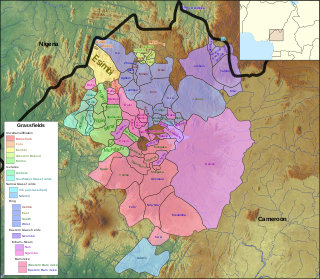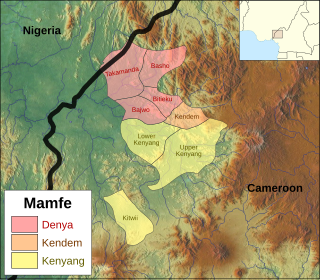Related Research Articles

Southern Bantoid is a branch of the Bantoid language family. It consists of the Bantu languages along with several small branches and isolates of eastern Nigeria and west-central Cameroon. Since the Bantu languages are spoken across most of Sub-Saharan Africa, Southern Bantoid comprises 643 languages as counted by Ethnologue, though many of these are mutually intelligible.
The Semi-Bantu or Semibantu are specific inhabitants of the Western grassfields of Cameroon, who speak languages that have certain characteristics to the Bantu language family but are excluded from them. The people themselves are considered ethnically and linguistically divergent from other Bantu peoples of central and southern Africa.

The Beboid languages are any of several groups of languages spoken principally in southwest Cameroon, although two languages are spoken over the border in Nigeria. They are probably not most closely related to each other. The Eastern Beboid languages may be most closely related to the Tivoid and Momo groups, though some of the geographical Western Beboid grouping may be closer to Ekoid and Bantu.

The Grassfields languages are a branch of the Southern Bantoid languages spoken in the Western High Plateau of Cameroon and some parts of Taraba state, Nigeria. Better known Grassfields languages include the Eastern Grassfields languages, Bamun, Yamba, Bali, and Bafut and the Ring languages, Kom, Nso, and Oku. Almost all of these languages are closely related, sharing approximately half of their vocabulary.
Busuu is an unclassified Southern Bantoid language of Cameroon. According to Ethnologue it is extinct. As of 2005 there were 3 speakers of the language. Busuu is an endangered language.

The Mamfe or Nyang languages are three languages that form a branch of Southern Bantoid languages spoken in southwest Cameroon. They are:

The Bendi languages are a small group of languages spoken in Cross River State, southeastern Nigeria. Bokyi is one of the Bendi languages having some speakers in Cameroon. Once counted among the Cross River languages, they may be a branch of Southern Bantoid, with observed similarities especially with the Ekoid languages.
The Furu languages are a proposed group of poorly attested extinct or nearly extinct and otherwise unclassified Southern Bantoid languages of Cameroon. Suggested Furu languages are:
Tikar is a Northern Bantoid, semi-Bantu language that is spoken in Cameroon by the Tikar people, as well as by the Bedzan Pygmies, who speak their own dialect of the language. A recent hypothesis by Roger Blench suggests that the Tikar language could be a divergent language in the Niger-Congo language family with an uncertain origin.
Tep is a Mambiloid language of Nigeria. Ethnologue considers it a dialect of Mambila, as speakers identify as Mambila, but it is a distinct language.
Gaa, or Tiba, is a poorly documented language of Nigeria. It is apparently one of the Dakoid languages.
Dong, or Donga, is a poorly documented language in Nigeria. Though clearly Niger–Congo, it is difficult to classify; British linguist Roger Blench proposes that it is one of the Dakoid languages, the closest to Gaa.
Fang is a Southern Bantoid language of Cameroon.
Koshin is a Southern Bantoid language of Cameroon. It is traditionally classified as a Western Beboid language, but that has not been demonstrated to be a valid family.
Mundabli is a Southern Bantoid language of Cameroon. It is traditionally classified as a Western Beboid language, but that has not been demonstrated to be a valid family.
Mbuʼ, or Ajumbu, is a Southern Bantoid language of Cameroon. It is traditionally classified as a Western Beboid language, but that has not been demonstrated to be a valid family. Inasmuch as Western Beboid may be valid, Mbuʼ would appear to be the most divergent of its languages.
Saari, or Nsari, is an Eastern Beboid language of Cameroon. According to Ethnologue, it's 84% lexically similar to Ncane, making it very close to the Noni cluster. It is spoken in the Misaje Sub-Division, Donga-Mantung Division, North West Region. The Ethnologue has Sari as the language name, and lists the following as alternate language names: Akweto, Nsari, Pesaa, Saari, Sali.
Chung (Cung) is an Eastern Beboid language of Cameroon.
The Mbwasa language is a Southern Bantoid language of Cameroon. It is very similar to Ki, and is sometimes considered a dialect of it.
Northern Bantoid is a branch of the Bantoid languages. It consists of the Mambiloid, Dakoid, and Tikar languages of eastern Nigeria and west-central Cameroon.
References
- ↑ Bikya at Ethnologue (25th ed., 2022)

- ↑ Dyer, Gwynne. "Profusion of tongues in the global village". Baltimore Sun . Retrieved 22 December 2020.
- ↑ Blench, Roger (7–9 April 2011). "The membership and internal structure of Bantoid and the border with Bantu" (PDF). Retrieved 5 March 2024.